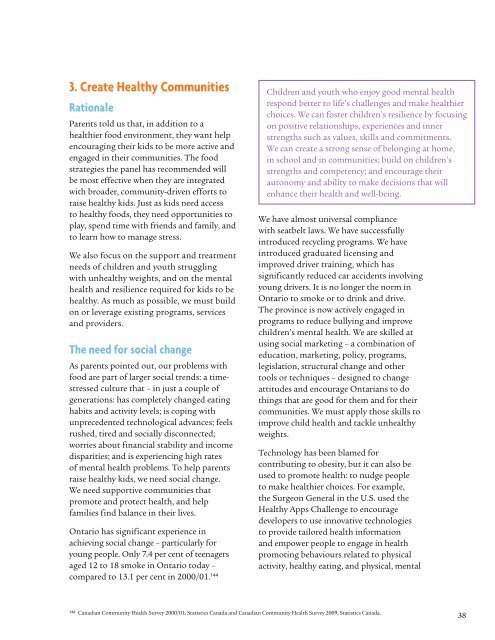No Time to Wait: The Health Kids Strategy - Ontario
No Time to Wait: The Health Kids Strategy - Ontario
No Time to Wait: The Health Kids Strategy - Ontario
- No tags were found...
You also want an ePaper? Increase the reach of your titles
YUMPU automatically turns print PDFs into web optimized ePapers that Google loves.
3. Create <strong>Health</strong>y CommunitiesRationaleParents <strong>to</strong>ld us that, in addition <strong>to</strong> ahealthier food environment, they want helpencouraging their kids <strong>to</strong> be more active andengaged in their communities. <strong>The</strong> foodstrategies the panel has recommended willbe most effective when they are integratedwith broader, community-driven efforts <strong>to</strong>raise healthy kids. Just as kids need access<strong>to</strong> healthy foods, they need opportunities <strong>to</strong>play, spend time with friends and family, and<strong>to</strong> learn how <strong>to</strong> manage stress.We also focus on the support and treatmentneeds of children and youth strugglingwith unhealthy weights, and on the mentalhealth and resilience required for kids <strong>to</strong> behealthy. As much as possible, we must buildon or leverage existing programs, servicesand providers.<strong>The</strong> need for social changeAs parents pointed out, our problems withfood are part of larger social trends: a timestressedculture that – in just a couple ofgenerations: has completely changed eatinghabits and activity levels; is coping withunprecedented technological advances; feelsrushed, tired and socially disconnected;worries about financial stability and incomedisparities; and is experiencing high ratesof mental health problems. To help parentsraise healthy kids, we need social change.We need supportive communities thatpromote and protect health, and helpfamilies find balance in their lives.<strong>Ontario</strong> has significant experience inachieving social change – particularly foryoung people. Only 7.4 per cent of teenagersaged 12 <strong>to</strong> 18 smoke in <strong>Ontario</strong> <strong>to</strong>day –compared <strong>to</strong> 13.1 per cent in 2000/01. 144Children and youth who enjoy good mental healthrespond better <strong>to</strong> life’s challenges and make healthierchoices. We can foster children’s resilience by focusingon positive relationships, experiences and innerstrengths such as values, skills and commitments.We can create a strong sense of belonging at home,in school and in communities; build on children’sstrengths and competency; and encourage theirau<strong>to</strong>nomy and ability <strong>to</strong> make decisions that willenhance their health and well-being.We have almost universal compliancewith seatbelt laws. We have successfullyintroduced recycling programs. We haveintroduced graduated licensing andimproved driver training, which hassignificantly reduced car accidents involvingyoung drivers. It is no longer the norm in<strong>Ontario</strong> <strong>to</strong> smoke or <strong>to</strong> drink and drive.<strong>The</strong> province is now actively engaged inprograms <strong>to</strong> reduce bullying and improvechildren’s mental health. We are skilled atusing social marketing – a combination ofeducation, marketing, policy, programs,legislation, structural change and other<strong>to</strong>ols or techniques – designed <strong>to</strong> changeattitudes and encourage Ontarians <strong>to</strong> dothings that are good for them and for theircommunities. We must apply those skills <strong>to</strong>improve child health and tackle unhealthyweights.Technology has been blamed forcontributing <strong>to</strong> obesity, but it can also beused <strong>to</strong> promote health: <strong>to</strong> nudge people<strong>to</strong> make healthier choices. For example,the Surgeon General in the U.S. used the<strong>Health</strong>y Apps Challenge <strong>to</strong> encouragedevelopers <strong>to</strong> use innovative technologies<strong>to</strong> provide tailored health informationand empower people <strong>to</strong> engage in healthpromoting behaviours related <strong>to</strong> physicalactivity, healthy eating, and physical, mental144 Canadian Community <strong>Health</strong> Survey 2000/01, Statistics Canada and Canadian Community <strong>Health</strong> Survey 2009, Statistics Canada.38
















